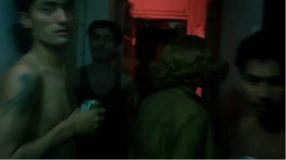CHUNG KING EXPRESS, dir. Wong Kar Wai(1994)
Chungking Mansions, Yau Tsim Mong District, Hong Kong
Jet Tone Film Production released Chungking Express in Hong Kong on July 14,1994.1 The film tells two love stories: an urban encounter between a lovelorn cop and a mysterious female assassin and the love story between patrolman 663 and a fast-food girl. Chungking Mansions was the centerpiece as the name of the film was taken from Chungking Mansions in Hong Kong, and the building was also used as one of the main scenes in the film.
The film opened with a scene of a girl with blonde hair (acted by Brigitte Lin) rushing into Chungking Mansions with a few policemen chasing her. We can’t see clearly which parts of the building that Lin actually passed through because Wong Kar Wai used shaky shots and out-of-focus images, which express the main characteristics of the building: chaotic, secluded, and crowded. In reality, Chungking Mansions is a residential building situated in Tsim Sha Tsui, which is filled with all kinds of small businesses and criminal activities and is full of cheap hotels known to backpackers from all over the world.
From the view of Wong Kar Wai, Chungking Mansion is the epitome of Tsim Sha Tsui as well as a presentation of the multicultural aspect of Hong Kong. “It’s a mix of Chinese and foreigners, with the most prominent features of Hong Kong society.” Chungking Mansion is presented in fragmented pieces in the film. This is the most realistic impression of a city that the public has initially, which is composed of several discrete slices of memories. “Chungking” is space and “Express” is time. “Chungking Express” is a homogenizing metaphor that connects two incompatible concepts. Space is the carrier for events, it becomes meaningful when people and activities intervene. The same space in the city will play out different events every moment. In your story, someone else maybe just a passerby beside you, simultaneously you may be just a background in someone else’s story. In Chungking Express, such a thing happened: a brush with a distance of only 0.01 cm occurred between the blonde and a policeman (acted by Takeshi Kaneshiro). The film does not create a postmodern city without “differences”; it creates a world that includes different values and attitudes that is full of conflicts and contradictions.2 The alternation of different events in the city and the repetition of the same space are perhaps the divine touch of the whole film beyond the emotional elements. Wong Kar Wai reflects his attachment to and detachment from this kind of urban life in the way of filming.


Female fugitive acted by Brigitte Lin side-steps through the crowded aisle. Scenes from ‘Chungking Express’,1994, directed by Wong Kar Wai.

A brush between the female fugitive and the cop (acted by Takeshi Kaneshiro). Scenes from ‘Chungking Express’,1994, directed by Wong Kar Wai.
—Lam Tsz Ching, u3595109
Notes:
- Produced by Jet Tone Film Production (Hong Kong) at an estimated budget of 15 million Hong Kong dollars, the film was directed as well as written by Wong Kar Wai and starred Hong Kong actress Brigitte Lin and Faye Wong, Hong Kong actor Tony Leung, and Japanese actor Takeshi Kaneshiro.
- Leung P.K. 2000. “Urban Cinema and the Cultural identity of Hong Kong.” In The Cinema of Hong Kong: History, Arts, Identity, ed. Fu, P. S. and Dresser, D., 227-51. Chicago: Cambridge University Press.
Some questions to consider: What do you understand by Leung’s point on how the film “does not create a postmodern city without ‘differences’” but “a world that includes different values and attitudes that is full of conflicts and contradictions”? Could you describe this through a specific scene (e.g. of the commercial spaces in Chungking Mansions) in the film and in comparison to your fieldwork analysis of that same space? Did you attempt to identify and visit physically or virtually the space/s in Chungking Mansions to understand how the film has captured it and what was changed or manipulated to emphasize the plot narrative? If you did not conduct a field trip in person, did you do so virtually, i.e. “visit it” through other people (media reports, personal blogs, videos, etc.) who had done it?
From what sources did you draw the conclusion that CKM is “filled with… criminal activities”? Be careful not to perpetuate popular rhetoric or easy judgments. If you have conducted online media research on the building, especially in the past few years, you will discover that such quick conclusions about the building and the activities within have caused the tenants and residents to experience social and racial prejudices and inconveniences. It would be meaningful to focus on the study of the commercial spaces as they are presented in the film and experienced in real life, whether you conduct the field trip physically yourself or virtually through online research to gather various perspectives so you can draw better-considered conclusions on how the space/s is narrated.